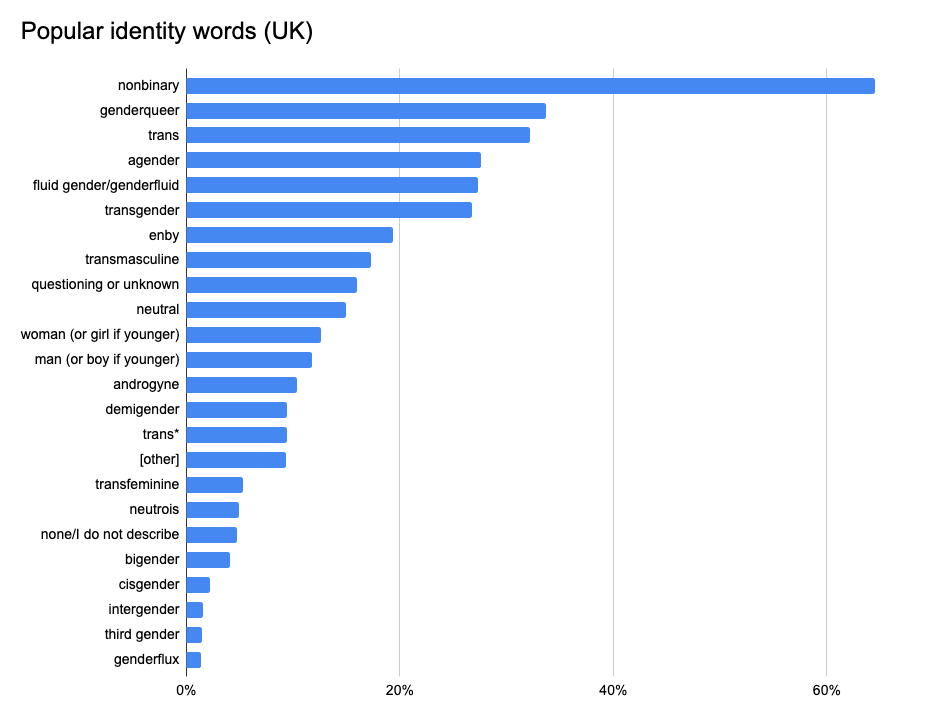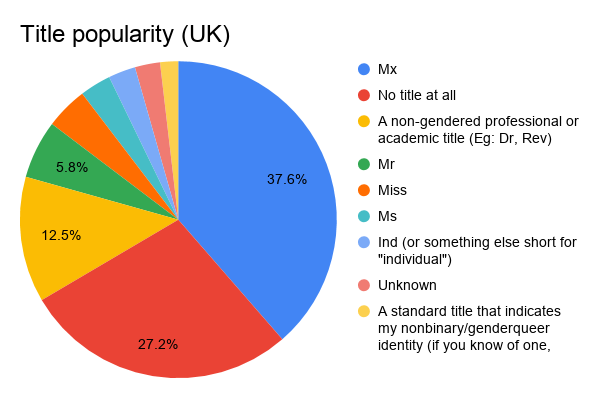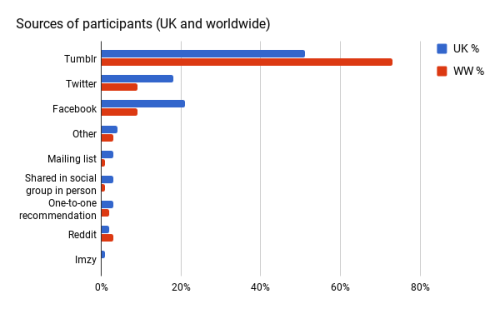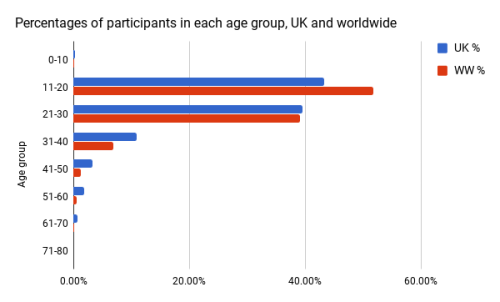Well, it’s been a wild year. Three times as many participants as usual, combined with new survey software and new spreadsheet software and health and financial difficulties, has caused some epic delay, plus a few more months of delay for the UK report – but we made it.
The survey ran from 6th February until 1st May 2017 (84 days), with 9,932 participants, of which 1,357 were in the UK. It was promoted on social networks, wherever participants were willing to share. People were invited to take part if they were not fully included in the binary of “anyone whose gender is always entirely and solely male, and anyone whose gender is always entirely and solely female.” It asked:
- Which words from a list (plus a textbox) participants identified with [optional, checkboxes];
- Which title from a list (plus a textbox) participants most wanted to use [optional, single answer only];
- Which pronouns from a list (plus a textbox) participants were happy with [optional, checkboxes];
- Whether the participant is in the UK [required];
- Age [required];
- How you found out about this survey [optional, checkboxes];
- The spelling of nonbinary/non-binary/non binary [optional, checkboxes].
A couple more questions were asked, the results of which I’ll not review in this report – I’ll go into more detail later.
[ LINK TO EXCEL SPREADSHEET OF RESULTS HERE ]
Question 1: Which of the following best describe(s) in English how you think of yourself?
The top five responses were:
- nonbinary – 64.5% (down 2.9%)
- genderqueer – 33.7% (down 6.5%)
- trans – 32.2% (down 3.9%)
- agender – 27.6% (up 0.2%)
- fluid gender/genderfluid – 27.3% 29.8 (down 2.5%)
Here’s the graph of identity words that got over 1%:

One identity word that wasn’t offered as a checkbox option made it over 1% this year both in the UK and worldwide, and will therefore be offered as a checkbox option next year: genderflux. That’s when one’s gender fluctuates in intensity without necessarily changing. (Not to be confused with genderfluid, when one’s gender changes.)
I will also be adding “binary” to the list next year – because I list cisgender alongside transgender, so it follows that I should list binary alongside nonbinary.
Some numbers I enjoyed:
- 23 identity words were offered in the survey.
- 23 identity words were typed into the “other” box more than once, and 60 identity words were typed into the “other” box only once.
- That’s 106 identity words total.
- People chose on average 3.7 identity words each – around the same as last year.
- The most common number of identity words chosen was one – 21% of participants chose one identity label, around the same as last year.
- 93% of people chose between 1 and 7 identity labels – a little higher than last year.
The worldwide report looks into the shifting popularity of the top ten words for both identity and pronouns, if you’re into that sort of thing.
A note on bias
It’s been bugging me for a couple of years that the survey is probably biased. I’ve been calling it variously the “nonbinary survey”, the “nonbinary/genderqueer survey”, etc. just because those terms are the most popular and I wanted to attract as many participants as possible. Unfortunately, this means that folks who identify as these things are more likely to opt in and take the survey, and people who don’t identify as these things are less likely to realise it’s aimed at them.
I wanted to try to change things this year, but the best I could manage was changing the title to NBGQ. I couldn’t think of a title that wasn’t long and rambling, like “the survey for people whose genders are not tidily described by the binary of ‘always entirely and wholly male’ and etc etc etc.” I suspect that the small change I made didn’t make much difference, so I will keep trying to find a better name.
Question 2: In a magical world where all title fields on forms were optional and write-your-own, what would you want yours to be in English?
This question allowed only one answer, though people very occasionally sneakily used the text box to tell me about either-or situations – and those titles were counted too.
The top 5 were:
- Mx – 37.6% (down 3.7%)
- No title at all – 27.2% (down 6.4%)
- Non-gendered professional or academic (eg: Dr) – 12.5% (up 3.6%)
- Mr – 5.8% (up 2.9%)
- Miss – 4.2% (up 1.8%)

(M was not offered as a checkbox option in the survey, but I’ve included it in this graph because it got more than “gendered professional or academic title”, which was offered in the survey.)
Mx and “no title” have swapped places each year since they were both included in the survey, so the fact that they’ve done so this year is not very notable.
This year I was able to include a text box to allow people who selected “a standard title that indicates my nonbinary/genderqueer identity” to write in what they use to do so. Of the 25 people who chose that option, 60% left that box blank. Each suggested title was entered only once.
A change I would like to make next year is to specify that participants should be currently entitled to use the title they choose. A lot of people choose “non-gendered professional or academic title” and then say “I’m going to get a doctorate so that I can use Dr”. There’s also often a smattering of people who enter military titles and nobility titles. People might be writing these in thanks to the “in an ideal world” tone of the question! So I would like to make the question more clear and specific to reduce that confusion.
Question 3: Supposing all pronouns were accepted by everyone without question and were easy to learn, which pronouns are you happy for people to use for you?
The top 5 are the same as last year:
- Singular they/them – 78.4% (down 0.4%)
- He/him – 29.8% (up 7.8%)
- She/her – 27.9% (up 3.9%)
- Mix it up – 11.9% (down 0.8%)
- None/avoid pronouns – 10.3% (up 0.4%)
9% of people didn’t select any of he, she or they – exactly the same as the international results.

More numbers:
- 9 specific pronouns were offered in the survey, along with 4 descriptions (for example, “none/avoid pronouns”).
- 13 pronouns were typed into the “other” box more than once.
- 44 pronouns were typed into the “other” box only once.
- That’s 71 pronouns total.
- People chose on average 2 acceptable pronouns each, the same as last year.
- Most people (44%) chose only one pronoun.
- About 72% of people were happy with only one or two pronouns.
The main change for this question is that last year I tried to combine the numbers for pronouns that were clearly intended to all be the same set, but with almost 10,000 participants that was just not possible. This year, the following hypothetical examples would have each been counted individually:
- xe/xem
- xe xem xirs
- xe/xem/xirself
…etc. There were 28 totally unique write-in entries worldwide for pronoun sets beginning with “ne”, and 26 for “ze” – many of them entered more than once.
Next year I am determined to collect information on each of the five forms of neopronouns, even if that means a participant has to fill out a five question section for each neopronoun they’ve claimed for themself. Ideally I would like to somehow create a form that will do this elegantly, but I know already that I can do it clumsily using Google Forms, so we’ll see. It’s important to me to count the more popular neopronouns accurately.
Notably, the “co” pronoun set was a checkbox option that got under 1% this year, and so it won’t be included as a checkbox option next year.
The worldwide report looks into the shifting popularity of the top ten words for both identity and pronouns, if you’re into that sort of thing.
The extra questions
There is more detailed investigation of the statistics regarding age and referring sites over in the worldwide report. For this report I’ll just show how the UK compared to the worldwide statistics:


UK people were more likely to find the survey via Facebook or Twitter and less likely to find it via Tumblr. Participants from the UK were also less likely to be teens and more likely to be over 30.
Again, I’ve given an overview of the results of the questions about the spelling of “nonbinary” and umbrella terms over on the worldwide report. I don’t feel that extracting the UK-only results would be very helpful; instead I’ll work on removing bias as much as possible in future surveys.
The questions I ask
- What should the third gender option on forms be called? – Still no consensus in that area. I won’t feel comfortable recommending the most popular (nonbinary) until I’ve done more work to remove bias in future surveys.
- Is there a standard neutral title yet? – Not yet. Mx is looking very promising, and is consistently far more popular than all other titles, but just as many nonbinary people want no title at all. It’s really important that activists campaigning for greater acceptance of gender diversity remember to fight for titles to be optional, too.
- Is there a pronoun that every nonbinary person is happy with? – As in previous years, no. The closest we have to a standard is singular they, and so I will use the data to campaign for journalists and anyone else with a style guide to allow it. But around 1 in 5 (20%) of us are not happy with singular they, and 9% of us don’t like he, she or they pronouns.
- Are any of the neopronouns gaining ground in a way that competes with singular they? – No. This year the closest is “Xe – xe/xem/xyr/xyrs/xemself” (9% in the UK compared to singular they’s 78%). Users of these neopronouns will probably not reach consensus for many years – language and especially pronouns can be very slow to settle and gain ground. Even if one neopronoun does become very commonly used, many will continue to use other neopronouns for a long time to come.
This year in review
There have been a lot of big changes.
- We tripled participation! We went from consistently ~2,000-3,000 participants worldwide to TEN THOUSAND. This still boggles me. I feel a little bit overwhelmed that you all trust me with personal information about yourself, and I am excited and honoured every year to play with all the delicious data. From a happily hyperfocused human to 9,932 participants, thank you. <3
- The survey now has its own social media presence! Which means people can follow me without having to put up with wittering about the survey, and people can follow the survey without having to put up with me wittering about… well, everything else. It probably helped the survey look more legit, which may in turn explain the increase in participation.
- I crowdfunded to cover costs! Originally this was just going to be the survey service, but then it ended up covering MS Excel as well. This process was fraught with hiccups and bad decisions, which is probably not surprising since I’ve never done this before. We reached the £330 target in only a few days, which was wonderful, and it helped a lot.
- I used a paid survey software service! Specifically, SmartSurvey. I would recommend it. They had a pay-monthly tier, which allowed me to subscribe to that with the crowdfund money and buy MS Excel in an emergency fashion to process the results when Google Sheets couldn’t handle 9,000+ responses, the wuss. SmartSurvey processed checkbox answers more helpfully, allowing me to process write-ins more easily, among many other lovely features. It wasn’t perfect, but it was a big improvement.
- I used MS Excel to process the results for the first time! This was not as much fun as Google Sheets. I had to learn a whole bunch of new techniques to count everything, and some of them didn’t even have Excel equivalents at all. It is also hella buggy and crashy on Mac. Overall, it’s pretty much been a nightmare.
- The results are therefore available as a MS Excel file instead of a Google Sheet this year. I am sad about this, because it’s less accessible in a lot of ways. Not everyone has access to Excel! Folks are of course welcome to download the files and mess about with the data however they want.
- In a more general sense, academics have approached me with questions about the results, even occasionally asking me for advice or telling me that they will be mentioning the survey in their [academic writings]. One person even sent me a French academic paper they’d found that referenced the 2016 survey, which was fun! I do think that anyone with relevant knowledge can probably see that my work is amateur and flawed, but nonetheless I still think it can be useful – and my experience this year is that it has been useful.
- Also in a more general sense, companies and organisations are clearly using the results of the survey to become nonbinary-inclusive. For example, HSBC introduced 10 new titles for nonbinary people this year and a fair few of them are popular among participants of the 2016 survey. Similarly, Bristol Water “did some research and found that [Mx, Ind and Misc] were the most popular” – they don’t refer to the survey directly but those three titles were the three most popular in the 2016 survey. I feel that the results of this survey are making it easier for companies who want to be inclusive to make changes, because let’s be honest, if it’s a choice between ignoring nonbinary people and doing expensive specialist research they’re going to ignore nonbinary people…
What I’ll do differently next year
- I will probably change the name of the survey and the associated social media URLs. This will be very disruptive, but I think it will improve the reliability of future survey results by reducing bias.
- I will continue to look for better survey and statistics software. Specifically, I want to ask about neopronouns in a better way, and I want software that can handle 10,000+ responses.
Closing thoughts
You are all awesome. I love that you are all willing to trust me with this stuff, and I feel very lucky to be able to do this whole thing because I find it really fun and interesting. I learn so much every time. Thanks for another great survey experience!
Support me!
First of all, I do this basically for free (the crowdfunded money went entirely on survey software and MS Excel), so if you happened to stumble onto my Amazon wishlist and accidentally fall on an Add To Cart button… well, I would be immensely grateful. 😉
Second, my girlfriend Andréa and I got really fed up of online dating and social network sites that were not fully inclusive of nonbinary and trans people. Either they don’t offer gender options for us, or they don’t include us properly in searches, or they force us into particular pronoun sets, or we are relegated to an “other” box, or all of the above. So we set about designing Starfriends.org (it was mostly Andréa), which uses a pretty revolutionary tagging system to match you with people based on all kinds of diverse stuff which can include gender if you want, and quite frankly the pronoun system is just VERY EXCITING, I’ve never seen anything like it on any other site. It’s pretty quiet and still in alpha (so it’s a little bit buggy and not fully fleshed out yet), but if this sounds like something you might be into, you’d be very welcome there. 🙂
2017-05-14
email: hello@gendercensus.com